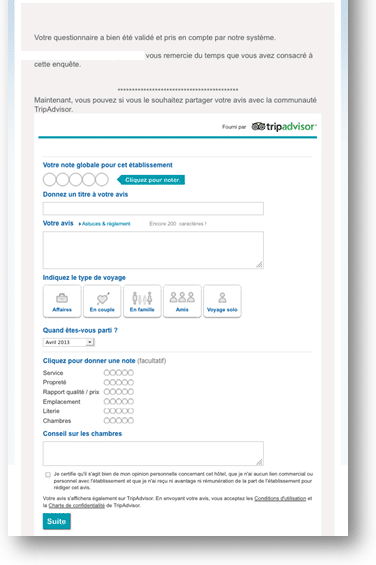sunday, december 10, 2017
How do you reconcile satisfaction surveys and online reviews?
Before making an online purchase or consuming a service, our first reflex is to get information from the Internet. These days, online reviews are an essential part of any company's marketing strategy. And that goes for all business sectors.
But can you be satisfied with a public feedback system to manage your Feedback Management program? Similarly, do you need online reviews when you already have a solid post-purchase questionnaire?
We'll see here that these two mechanisms (online questionnaire and public notice) are absolutely complementary.
Satisfaction surveys and online reviews: different objectives
Satisfaction surveys and online reviews, even if they are written by the same people (customers) and talk about the same thing (the service provided), have different objectives.
The primary objective of a customer satisfaction survey is to help the company improve the service it provides. In his comments, the customer will be specific about the problem encountered. They should mention the room number and the name of the receptionist to be congratulated.
The aim of online reviews is to help Internet users make the right choice. Reviews talk about the location of the holiday, and the difficulties encountered in getting there. They also talk about the service provided, but in more generic terms, and not in sufficient detail to trigger specific corrective action on the part of the organization.
The satisfaction survey is a tool for operational staff. Online reviews are a marketing tool. Although the two worlds are intrinsically linked, they have different priorities and fields of action.
Online reviews can be fed by satisfaction surveys
As both universes are fed by the same customers, it can be interesting to make the two cohabit.
For one of our clients in the tourism sector, we carried out a case study on the impact of online reviews submitted by respondents to our satisfaction questionnaires. The TripAdvisor form was displayed directly on the survey's thank-you page.

The conclusions of this case study are very interesting:
- Multiplication of the number of reviews published: after the insertion of this form, the number of reviews multiplied by 3. In concrete terms, the notices pushed by this system represented 75% of all notices published in a given month.
- More positive reviews: +4% on the average e-reputation score. So-called organic reviews are filled in by customers who are less satisfied with the service.
Conclusion
As we can see, satisfaction surveys and online reviews, far from competing with each other, complement each other and meet similar but different objectives. Neither approach should be neglected.